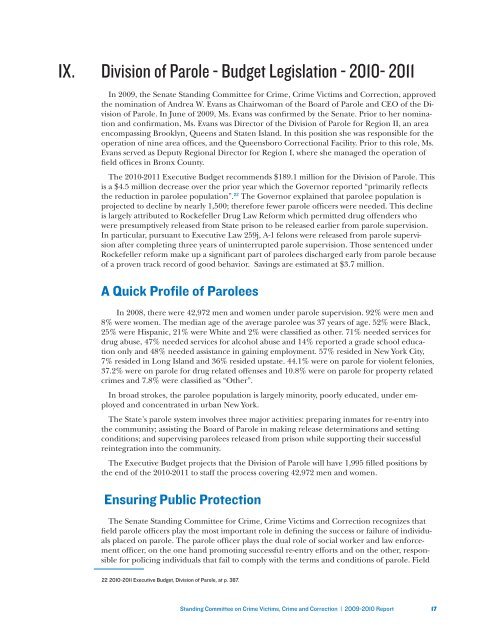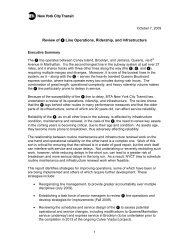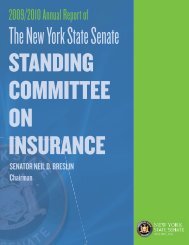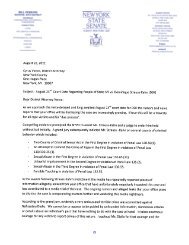Crime Committee Report e.indd - New York State Senate
Crime Committee Report e.indd - New York State Senate
Crime Committee Report e.indd - New York State Senate
You also want an ePaper? Increase the reach of your titles
YUMPU automatically turns print PDFs into web optimized ePapers that Google loves.
IX. Division of Parole - Budget Legislation - 2010- 2011<br />
In 2009, the <strong>Senate</strong> Standing <strong>Committee</strong> for <strong>Crime</strong>, <strong>Crime</strong> Victims and Correction, approved<br />
the nomination of Andrea W. Evans as Chairwoman of the Board of Parole and CEO of the Division<br />
of Parole. In June of 2009, Ms. Evans was confirmed by the <strong>Senate</strong>. Prior to her nomination<br />
and confirmation, Ms. Evans was Director of the Division of Parole for Region II, an area<br />
encompassing Brooklyn, Queens and <strong>State</strong>n Island. In this position she was responsible for the<br />
operation of nine area offices, and the Queensboro Correctional Facility. Prior to this role, Ms.<br />
Evans served as Deputy Regional Director for Region I, where she managed the operation of<br />
field offices in Bronx County.<br />
The 2010-2011 Executive Budget recommends $189.1 million for the Division of Parole. This<br />
is a $4.5 million decrease over the prior year which the Governor reported “primarily reflects<br />
the reduction in parolee population”. 22 The Governor explained that parolee population is<br />
projected to decline by nearly 1,500; therefore fewer parole officers were needed. This decline<br />
is largely attributed to Rockefeller Drug Law Reform which permitted drug offenders who<br />
were presumptively released from <strong>State</strong> prison to be released earlier from parole supervision.<br />
In particular, pursuant to Executive Law 259j, A-1 felons were released from parole supervision<br />
after completing three years of uninterrupted parole supervision. Those sentenced under<br />
Rockefeller reform make up a significant part of parolees discharged early from parole because<br />
of a proven track record of good behavior. Savings are estimated at $3.7 million.<br />
A Quick Profile of Parolees<br />
In 2008, there were 42,972 men and women under parole supervision. 92% were men and<br />
8% were women. The median age of the average parolee was 37 years of age. 52% were Black,<br />
25% were Hispanic, 21% were White and 2% were classified as other. 71% needed services for<br />
drug abuse, 47% needed services for alcohol abuse and 14% reported a grade school education<br />
only and 48% needed assistance in gaining employment. 57% resided in <strong>New</strong> <strong>York</strong> City,<br />
7% resided in Long Island and 36% resided upstate. 44.1% were on parole for violent felonies,<br />
37.2% were on parole for drug related offenses and 10.8% were on parole for property related<br />
crimes and 7.8% were classified as “Other”.<br />
In broad strokes, the parolee population is largely minority, poorly educated, under employed<br />
and concentrated in urban <strong>New</strong> <strong>York</strong>.<br />
The <strong>State</strong>’s parole system involves three major activities: preparing inmates for re-entry into<br />
the community; assisting the Board of Parole in making release determinations and setting<br />
conditions; and supervising parolees released from prison while supporting their successful<br />
reintegration into the community.<br />
The Executive Budget projects that the Division of Parole will have 1,995 filled positions by<br />
the end of the 2010-2011 to staff the process covering 42,972 men and women.<br />
Ensuring Public Protection<br />
The <strong>Senate</strong> Standing <strong>Committee</strong> for <strong>Crime</strong>, <strong>Crime</strong> Victims and Correction recognizes that<br />
field parole officers play the most important role in defining the success or failure of individuals<br />
placed on parole. The parole officer plays the dual role of social worker and law enforcement<br />
officer, on the one hand promoting successful re-entry efforts and on the other, responsible<br />
for policing individuals that fail to comply with the terms and conditions of parole. Field<br />
22 2010-2011 Executive Budget, Division of Parole, at p. 387.<br />
Standing <strong>Committee</strong> on <strong>Crime</strong> Victims, <strong>Crime</strong> and Correction | 2009-2010 <strong>Report</strong> 17









![[PDF] Proposed MTA Capital Program - New York State Senate](https://img.yumpu.com/24854139/1/190x245/pdf-proposed-mta-capital-program-new-york-state-senate.jpg?quality=85)






